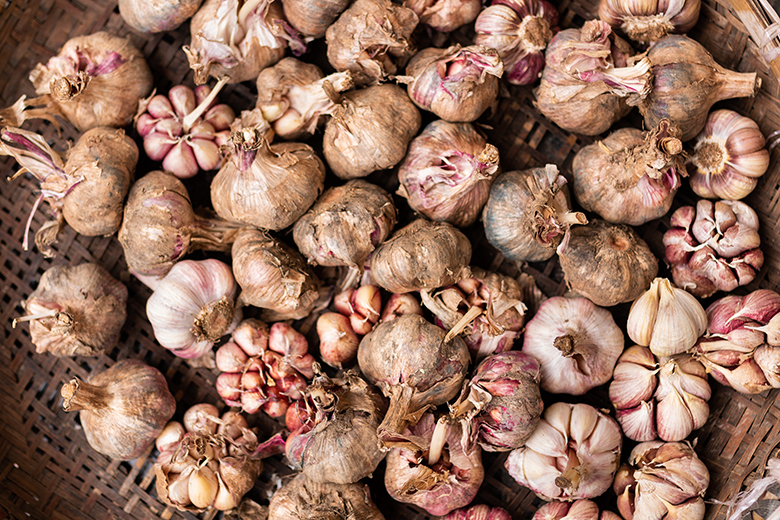
Many new cookbooks don’t simply provide recipes: They give culinary road maps. The trend, since the massive success of Salt Fat Acid Heat by Samin Nosrat, has been to offer readers, yes, well-written instruction for specific dishes, but also the tools to go off in their own directions with what they’ve learned.
Read more: Samin Nosrat’s 5 Essential Cookbooks
Ronna Welsh’s new book The Nimble Cook: New Strategies for Great Meals That Make the Most of Your Ingredients is organized seasonally. First there is the kind of ingredient, followed by her favorite preparations as well as ways to use the prepared ingredients in other dishes. For the home cook who struggles with how to prep their fresh farmers market haul and work it into various meals so that the week doesn’t soon get boring, The Nimble Cook can change how ingredients are seen and interpreted. What she calls “starting points” can include a raw sliced onion, or maybe it’s caramelized. When a salad is being prepared, the various components also provide the start of new meals: Excess greens can go into a soup, for example, or cucumbers can be added to a cold noodle dish—maybe the dressing would work well with fish.

This type of thinking, in Welsh’s view, will lead someone to shop not for what might be needed in a specific recipe but to focus on ingredients, cook with what’s on hand, and sometimes surprise themselves in the process. Being “nimble” in the kitchen here means less waste and more openness to seasonality. She gives instructions on how to store ingredients for a longer shelf life, use parts of vegetables that might otherwise be thrown away, and do more interesting things with items that might not immediately come to mind—braised celery, for instance, changes the flavor profile of a vegetable commonly misunderstood as filler, a health necessity more than a compelling aspect of a meal.
Read more: These Sunset Park-Based Classes Teach Zero-Waste Cooking Techniques
Ordinary cooking techniques applied in surprising ways make this book worthwhile even for someone who thinks they know all about prep, storage and making an interesting meal out of a pantry that hasn’t been stocked in weeks. Nearly everything, Welsh proves, can be given new life in pickling; beet peels can be turned into vinegar, and then a beet-peel vinaigrette. Braised celeriac can become a gratin or a soup. The water in which potatoes are boiled becomes broth. Mushrooms are triple-braised and served with garlic-skin vinegar (recipe below). She makes simmering up a mushroom or even nut stock feel easy and sensible.
Welsh’s expertise, of course, has been borne of great experience: She’s the owner of Purple Kale Kitchenworks, a cooking school in New York focused on simple, efficient cooking that doesn’t lack in creativity. While The Nimble Cook seems to be part of a new tradition in cookbooks (fans will certainly also want Abra Berens’s forthcoming Ruffage: A Practical Guide to Vegetables), it will serve traditionalists well, too, with clear instruction, commonly found ingredients and adaptability to pretty much any dietary restrictions or allergies. Here, the title does not lie: Every reader will come away a bit more flexible in the kitchen, whether they choose to start making vinegars from garlic skins or not.
Garlic-Skin Vinegar
https://www.instagram.com/p/BvwJng2Bg8K/
On my way to the trash with a handful of messy poached garlic skins, I knocked over a bottle of cheap red wine vinegar. I tossed the peels onto the counter, freeing my hands to grab paper towels—the flavored vinegar practically made itself.
With mustard and oil, this vinegar makes a quick dressing for asparagus, young beets or dandelion greens. Sometimes I put it on the table instead of olive oil for dipping good bread.
Makes 1 cup
INGREDIENTS
Pinch of fennel seeds
1 bay leaf
1 cardamom pod
10 black peppercorns
2 tablespoons unsalted butter, at room temperature
Packed ½ cup Poached Garlic Skins (see recipe below)
1 cup red wine vinegar
DIRECTIONS
Place all the ingredients into a glass bottle or canning jar and cover. Shake well. Leave at room temperature to marinate for 48 hours. Refrigerate to store; do not strain. The vinegar is best after at least 1 week and only improves with time. It will keep, refrigerated, for 2 months.
Poached Garlic Skins
Cooked slowly in water, garlic cloves turn mellow, deeply fragrant and, curiously, a bit sweet. I make poached garlic more often than the pungent roasted garlic, which for me has a limited range. Poached garlic is silky and smooth. With it, you can enrich plain broth or flat beans and give light body to countless other things. It makes a delicious spread for sandwiches, too. Put out a plate of poached garlic cloves, their skins slit with a knife, then squeeze the soft garlic straight into your mouth.
Poached garlic requires no prep work beyond breaking off the cloves from their stem. You don’t even need to peel them. Although you don’t need to cook six heads at once, the more you cook, the more flavorful the resulting broth.
Makes ½ cup skins, packed
INGREDIENTS
6 garlic heads, broken up into cloves, unpeeled
2–2½ cups water
½ cup excellent olive oil (optional)
¾ or more teaspoon coarse kosher salt (optional)
DIRECTIONS
Place the garlic cloves into a small saucepan. Add the water to just cover the cloves. Cover and cook on medium heat, at a meaningful simmer, until the garlic is very tender, about 15 minutes. Remove the cloves from the liquid to cool, reserving the garlic broth for soup or Garlic Stock.
Once the cloves are cool, you can either slip them from their skins and submerge them in the oil or make the cloves into puree.
Garlic-Skin Vinegar is excerpted from The Nimble Cook: New Strategies for Great Meals That Make the Most of Your Ingredients. © 2019 by Ronna Welsh.
Illustrations © 2019 by Diana Vassar. Reproduced by permission of RuxMartin Books/Houghton Mifflin Harcourt. All rights reserved.



